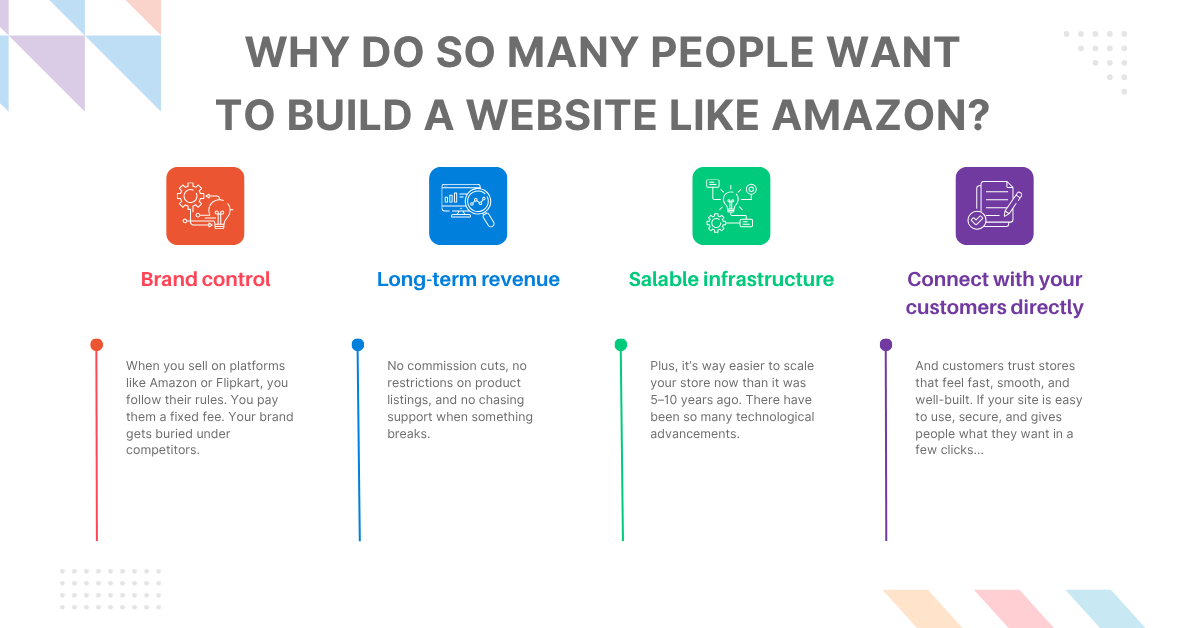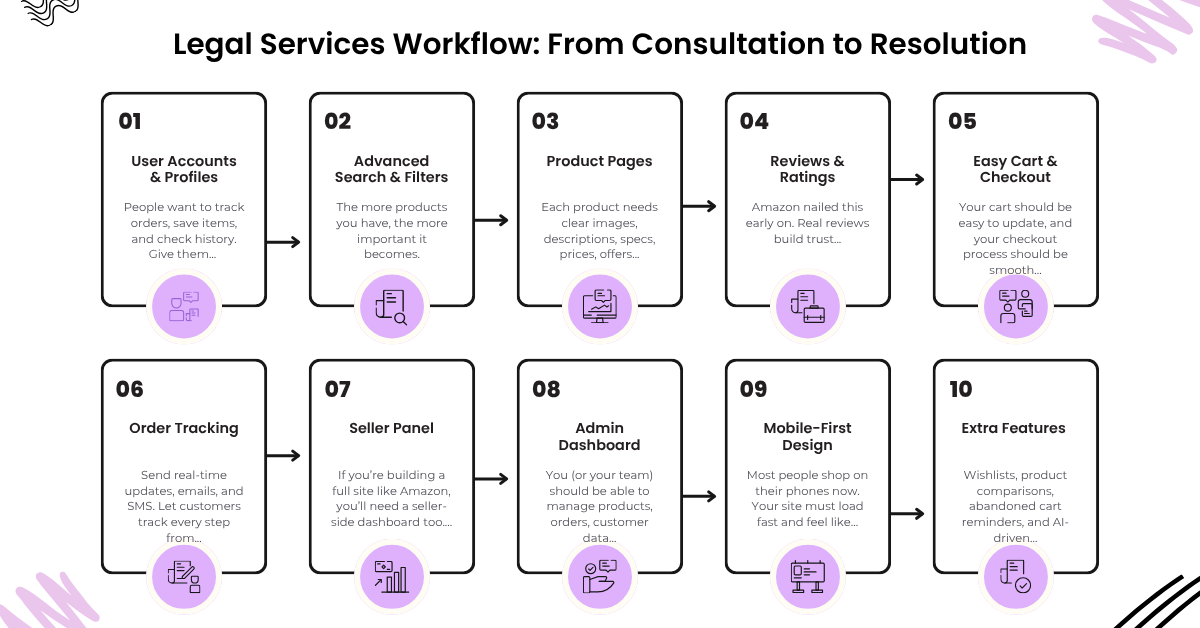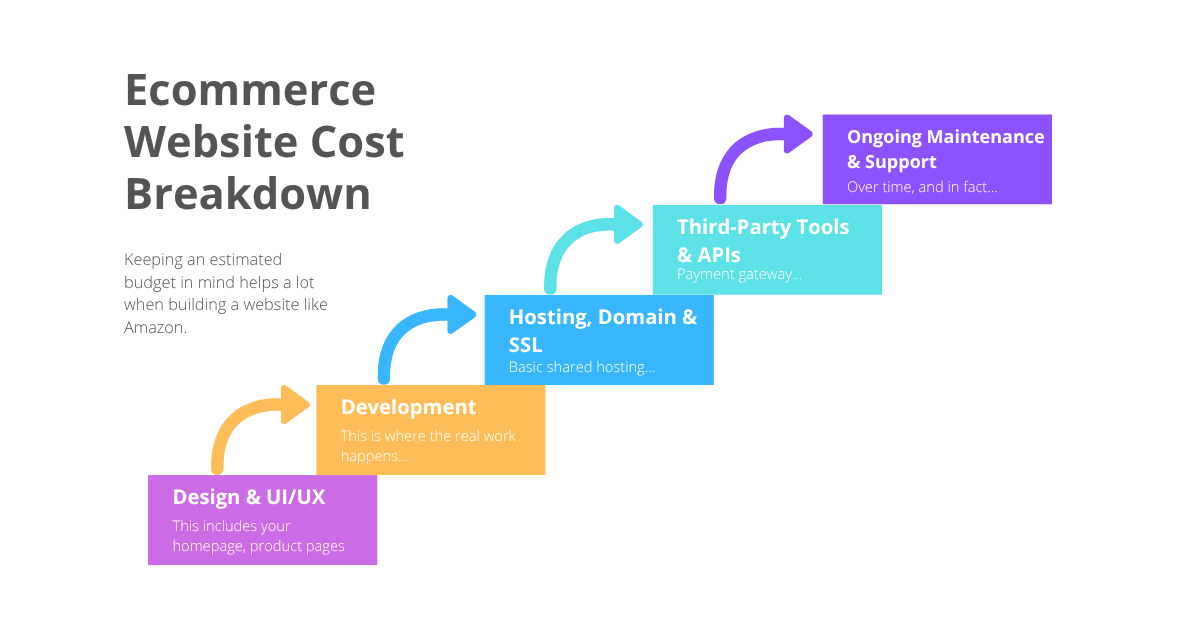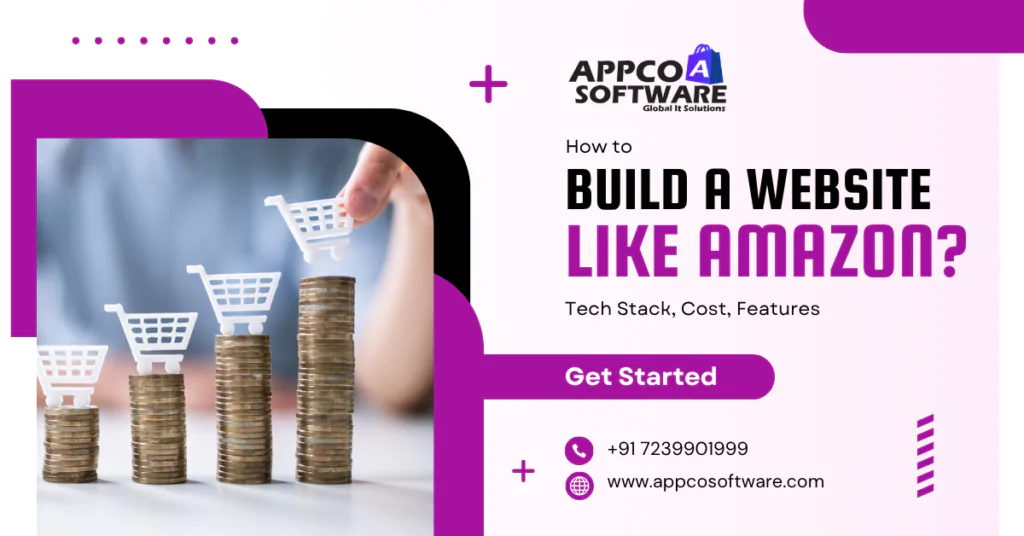More than 33% of people around the world now shop online. And global eCommerce sales crossed $6.3 trillion in 2024. And by 2027, it’s expected to hit $8 trillion.
And if you can guess who’s still leading the market, it’s Amazon. It’s not just a store anymore, but Amazon is now a go-to place when people think of online shopping.
So if you’ve got a product, a vision, or you’re just tired of selling through third-party platforms that take a cut from everything, building your own website like Amazon may be your best option.
In reality, however, making something that even comes close to Amazon takes more than slapping products on a website. You’ll need a plan. You’ll need the right tools. And you’ll need to know where to invest your money, and where not to.
This guide is for anyone who’s serious about building an actual ecommerce online store. We’re going to break it down:
- What features do you need (and what you don’t)
- The tech stack behind a site like Amazon
- How much it could cost to make an ecommerce website
- And the smartest way to get it built — even if you’re not a developer
eCommerce Market 2025: Quick Stats You Should Know
If you’re thinking about building your own ecommerce store, now might be the best time to get in.
Here’s what the numbers are saying:
- Global eCommerce sales are on track to hit $4.79 trillion by the end of 2025.
- From 2022 to 2028, the market is expected to grow by nearly 58%, increasing from $5.13 trillion to $8.09 trillion.
- China’s still leading the market, earning over $3 trillion in 2024 alone.
- The Asia-Pacific region is set to own 80% of the global B2B share by 2026. That’s part of a $36 trillion B2B ecommerce market.
- After COVID, online shopping grew like crazy, pushing the industry forward by around 5 years.
- Mobile commerce is now a beast of its own, bringing in $2.07 trillion in 2024.
- Cross-border eCommerce, that’s already hit $791.5 billion and is growing at over 30% CAGR through 2031.
- Virtual selling is the new normal, with 92% of B2B brands already running sales online.
- By 2025, nearly 42.4% of the world’s population will be active eCommerce shoppers. That’ll grow to almost half the planet by 2029.
Why Do So Many People Want to Build a Website Like Amazon?

You’ve probably noticed that every other brand, startup, or small business is trying to launch an ecommerce website that looks and works like Amazon. And no, we are not talking about the design or the layout people are copying. But we are considering building something that runs smoothly, handles scale, and gives users a reason to come back.
So, why are so many people aiming to build a site like Amazon in the first place? The answer is simple: control and growth.
1. Brand control
When you sell on platforms like Amazon or Flipkart, you follow their rules. You pay them a fixed fee. Your brand gets buried under competitors. But when you make an ecommerce website of your own, everything changes. You control your pricing, how your store looks, how products are showcased, and most importantly, how your customers experience the buying journey.
2. Long-term revenue
No commission cuts, no restrictions on product listings, and no chasing support when something breaks. Everything is yours, from the traffic to the customer database.
3. Scalable infrastructure
Plus, it’s way easier to scale your store now than it was 5–10 years ago. There have been so many technological advancements. Whether you’re selling 10 products or 10,000, you can manage inventory, payments, delivery, and even customer support from one backend dashboard — just like the big players do.
4. Connect with your customers directly
And customers trust stores that feel fast, smooth, and well-built. If your site is easy to use, secure, and gives people what they want in a few clicks, they’ll stick around. Amazon provides that. Now it’s your turn to take that strategy and make it work for your niche.
Core Features You’ll Need to Build a Website Like Amazon

If you’re planning to build a shopping website that even comes close to Amazon, you can’t just focus on how it looks. You’ve got to make sure the code behind it runs smoothly, scales well, and actually delivers what people expect from a proper ecommerce online store.
Here’s what your site needs to have:
1. User Accounts & Profiles
People want to track orders, save items, and check history. Give them a clean, simple login and profile dashboard. Guest checkout is fine, but accounts keep them visiting again.
2. Advanced Search & Filters
The more products you have, the more important it becomes. Fast search, category filters, price sliders, brand sorters. Now, it is all part of the shopping experience.
3. Product Pages
Each product needs clear images, descriptions, specs, prices, offers, delivery info, and maybe a size chart. Keep it clean, mobile-friendly, and trust-building.
4. Reviews & Ratings
Amazon nailed this early on. Real reviews build trust. Let buyers rate and review, and make it easy to filter by that too.
5. Easy Cart & Checkout
Your cart should be easy to update, and your checkout process should be smooth. Auto-fill, multiple payment options, and minimal steps will increase sales.
6. Order Tracking
Send real-time updates, emails, and SMS. Let customers track every step from “Order Placed” to “Delivered.”
7. Seller Panel
If you’re building a full site like Amazon, you’ll need a seller-side dashboard too. Inventory, shipping, analytics, and payouts, to give sellers the tools they need.
8. Admin Dashboard
You (or your team) should be able to manage products, orders, customer data, offers, and reports. All from one clean backend.
9. Mobile-First Design
Most people shop on their phones now. Your site must load fast and feel like an app, even if it’s in a browser.
10. Extra Features
Wishlists, product comparisons, abandoned cart reminders, and AI-driven recommendations — these are optional at first, but super useful when you’re growing.
Tech Stack to Build a Website Like Amazon
Until now, we have figured out an essential list of features. Now the big question is: What technology will be used to build this?
You need a good tech stack if you want to make a website like Amazon. Here are the technologies you could use while developing the site:
1. Frontend
- React.js or Vue.js – Clean UI, fast rendering, flexible for complex stores
- Next.js – Great if you want super-fast page loads and SEO performance
- Tailwind CSS or Bootstrap – For layout and mobile-friendly styling
2. Backend
- Node.js or Laravel – Reliable and scalable for handling orders, payments, etc.
- Django (if you’re going with Python-based dev)
- Express.js – For lightweight APIs and faster data flow
3. Database
- PostgreSQL – Ideal for handling complex data like products, users, and inventory
- MongoDB – Works well if you need flexibility and faster dev speed
4. Hosting & Server
- AWS – Most common, scalable, and secure
- DigitalOcean – Affordable and beginner-friendly
- Cloudflare – For CDN and extra security
5. Payments
- Stripe, Razorpay, PayPal – Support global and local payments
- Easy to integrate and comes with a dashboard for transaction tracking
6. Optional Tools & APIs
- Headless CMS (if you want content flexibility)
- Elasticsearch (for super-fast product search)
- Redis or Memcached (for caching and speed)
Also Read – Shopify vs WooCommerce vs Magento
Ecommerce Website Cost Breakdown

Keeping an estimated budget in mind helps a lot when building a website like Amazon. And it is not something you figure out on a weekend and launch on Monday morning. It takes time, planning, and a lot more things down the line.
But also, you would not need crores to do that. You just need to be clear about what you’re building, who’s building it, and how far you want to go with the features.
Here’s how the ecommerce website cost usually breaks down:
Please note: The estimated cost we are adding in the section below is not fixed. It can change according to your personal requirements. This is just a basic idea of how much you can expect to create a website like Amazon.
1. Design & UI/UX
This includes your homepage, product pages, cart, mobile layouts, etc.
- Basic layout using pre-built templates: ₹25K – ₹50K
- Custom design from scratch: ₹80K – ₹2L+
2. Development (Frontend + Backend)
This is where the real work happens. Developers will build your product pages, cart, filters, login system, checkout, etc.
- Using platforms like Shopify/WooCommerce: ₹40K – ₹1L
- Custom built with full control: ₹2L – ₹10L+
3. Hosting, Domain & SSL
- Basic shared hosting: ₹5K/year
- Scalable cloud hosting (like AWS): ₹1,500–₹5,000/month
- SSL: Often free or bundled with hosting
4. Third-Party Tools & APIs
- Payment gateway (Stripe, Razorpay, etc.)
- Email/SMS notifications
- Analytics and marketing tools
5. Ongoing Maintenance & Support
Over time, to run a successful eCommerce business, you’ll need updates, fixes, backups, and some security checks.
If you work with an eCommerce website developer, most will offer this as a monthly fee. Expect ₹10K–₹25K/month depending on your setup.
How to Hire the Right Team to Build Your Ecommerce Online Store
Now after setting a budget in mind, we have reached the very important part of development. And that is hiring a website development company. Your idea might be solid, your budget might be decent, and your plan might look great on paper. But if the people building your ecommerce online store don’t get what you’re trying to do, then the game is over.
Selecting the right team is not as simple as choosing the cheapest developer or the most expensive agency. It’s about finding someone who understands what it takes to build a site like Amazon — from the way products are shown, to how the backend handles orders at scale.
So what should you look for?
1. Experienced Team
A portfolio full of restaurant landing pages and personal blogs. That’s not who you want. You need ecommerce website developers who’ve worked on real stores, especially ones with carts, filters, user dashboards, payment gateways, and admin panels.
Ask them:
- Have you built a shopping site before?
- Can you show a working example with a live backend?
- How do you handle mobile performance and speed?
2. Full-Stack Tech
You don’t need one person who does it all, but you do need someone (or a team) who understands how the frontend corresponds to the back end. And how the database stores orders, and how APIs plug in to make things smoother.
3. Cost-effective Solution
If they can’t explain their plan in simple words, find someone else who can. You should know what you’re paying for. Wireframes, timelines, features, post-launch support — everything should be clear before you sign anything.
4. Freelancers vs Agencies
Freelancers are ideally suited for smaller builds, quick fixes, or MVPs. But if you’re planning something serious, a custom multi-vendor store or something built to scale —an eCommerce agency would be a better choice. The company will have a front-end developer, a back-end developer, a QA engineer, and a support team under one roof.
How Long Does It Take to Build a Site Like Amazon?
This is one of the very first questions people ask, and it is quite important. You’ve got plans, maybe a product to sell, and you’re trying to figure out how soon you can launch your ecommerce online store.
Now here’s the short answer: it depends on what you’re building.
You can create a simple online store in three to five weeks if you wish to list products, accept payments, and handle basic orders. Particularly if you use an e-commerce platform such as Shopify or WooCommerce.
But if you’re trying to build a website like Amazon, with some of the industry-best custom filters, user accounts, admin tools, seller panels, reviews, and full backend control — that’s a whole other story. You should expect to spend a minimum of 3 to 6 months developing a fully functional version, and even longer if you are creating complex features from scratch.
Here’s a basic timeline breakdown:
- 1–2 Weeks: Planning, wireframes, feature list
- 3–4 Weeks: UI/UX design
- 4–8 Weeks: Backend + frontend development
- 2–3 Weeks: Testing, QA, bug fixes
- 1 Week: Launch prep, hosting, domain, SSL
Should You Build from Scratch or Use a Platform?
When you’re planning to build an e-commerce website, the first big decision is whether you should build using a platform or from scratch. And that is kind of an important thing you need to decide at the very beginning.
1. Using Platforms Like Shopify, WooCommerce
A good choice for:
- Quick launch
- Small to mid-sized stores
- People with a limited budget
With platforms like Shopify and WooCommerce, you don’t need to code much. You pick a theme, upload products, set up payments, and you’re live. But you’ll always be limited by the platform. And if you need some custom features, you’ll need to work with paid plugins or need to write code.
2. Building from Scratch
A good choice for:
- Unique marketplaces
- Advanced features
- Full control and long-term growth
When you build it with a skilled team, you get full control. In this case, you can build anything you like. For example, custom features in the seller panel, and a custom search system, checkout & cart features. Yes, it takes considerably more time to develop a website like Amazon from scratch. And of course, more money.
Amazon Clone vs. Custom Ecommerce Website: What’s Right for You?
Before you go all in trying to build a website like Amazon, there’s one thing worth asking: Do you need something that big? Or are you just trying to launch a clean, powerful store that works well and brings in real orders?
See, there’s a big difference between cloning Amazon and building a solid ecommerce site. Amazon wasn’t built overnight. It’s got layers of features: one-click checkout, massive search infrastructure, complex inventory systems, multiple seller logins, shipping integrations, and way more. Rebuilding all that means it would take a lot of time, money, and a full dev team.
In our personal opinion, most businesses don’t need 90% of what Amazon offers. All they need is a website that’s fast, mobile-friendly, secure, and easy to manage. If your goal is to sell your products or launch a Shopify-based ecommerce store, you should make a custom site instead of copying everything Amazon does.
A custom site lets you build only what you need, which means a better user experience and less stuff to maintain. You get more control over branding, layout, and customer flow.
How Appco Software Can Help You Build a Website Like Amazon
At Appco Software, we’ve worked with startups, D2C brands, and growing businesses over the years. We help you plan everything, from feature lists to design, tech stack, and post-launch support.
Whether you’re building a simple eCommerce online store or a full-scale multi-vendor marketplace like Amazon, we can help you in any case. Our team of expert designers and certified developers know how to make things work. When you work with us, you will know exactly what is being built, how long it will take, and how much it will cost.
We handle everything in-house: design, development, testing, optimization, and maintenance. Having said that, you do not need to contact five different freelancers in order to resolve one issue. We offer you everything under one roof.
Also Read – How to Create a Shopify Store: Step-by-Step Guide
The Final Say
If you’ve read this far, you’re not just thinking about launching another online store — you’re aiming to build a real website like Amazon, something that can grow with your business and actually compete in today’s market.
We’ve covered a lot. From key features and the tech stack to timelines, costs, and even the decision between building from scratch or using a platform. Whether you’re starting with a few products or planning to launch a full multi-vendor eCommerce online store, one thing stays the same: how well your site works will directly impact how much you sell.
Please do not rush the process. Pick the right tools, hire the right team, and focus on building something that’s fast, clean, and made for real users.
Build a Website Like Amazon FAQs
1. How much does it cost to build a website like Amazon?
A basic store might cost around ₹1L. If you want something big, like multi-vendor or fully custom features, expect ₹5L or more. It depends on what you’re building.
2. Can I build it on Shopify?
Shopify is great for big stores. But for a site like Amazon with sellers, filters, and custom logic, you’ll need something more flexible.
3. How long does it take to build something like this?
Basic sites can go live in a month. But big platforms with all the features can take 3 to 6 months to build it properly.
4. Do I need a full team or just one developer?
For small jobs, one person might handle it. But for a proper ecommerce online store, a team of developers, software engineers, and testers would be ideal.


5 Replies to “How to Build a Website Like Amazon? Tech Stack, Cost, Features”
Boyarka
fantastic publish, very informative. I’m wondering why the opposite specialists
of this sector don’t realize this. You should proceed your writing.
I am sure, you’ve a huge readers’
Nova
Very good blog it will help get me create a good website.
Jeffrey Ovask
Well-structured and insightful. This is exactly what I was looking for.
Anonymous
Very useful information! I’ll definitely be applying some of these tips in my work.
Michael
Excellent write-up! You covered all the important points in a clear and concise manner.